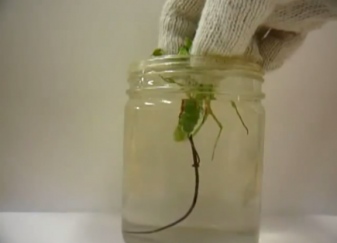
If you're an arthropod like a crab, beetle, cockroach or mantid, horsehair worms are your worst nightmare. Belonging to the phylum Nematomorpha, these parasitic invertebrates can stretch up to 2 metres long, and they're found terrorising hosts all over the world, mainly in freshwater environments.
As adults, horsehair worms are free-living creatures and they make their homes in water sources such as swimming pools, streams, puddles, cisterns, and watering troughs. The larvae, on the other hand, can't swim, so they'll wait to be eaten by an unsuspecting host, and once inside their haemocoel - a specialised circulatory system - they grow fat and large by absorbing the host's internal nutrients through their skin.
Matt Simon explains over at Wired:
"There's no digestive system as we would recognise it, because like the tapeworms that take up residence in our guts, they're living in a veritable sea of food. "The way that these guys actually get their nutrients is right through the cuticle," said [University of New Mexico parasitologist, Ben] Hanelt. "Right through the skin of the worm is where the fat and the sugar is actually absorbed straight from the body fluids of the host."
Depending on the species, it can take several weeks or months for a horsehair worm larva to grow into its adult form, and it will moult several times inside its host in the process. Once fully grown, the horsehair worm will infect its host's brain, compelling it to seek out the nearest source of water and drown itself, making the parasite's transition into its adult home quick and painless. Amazingly, even if its host is eaten by a larger predator, the horsehair worm will have no problems extricating itself.
By the the way, if you think one horsehair worm wriggling out of a praying mantis is gross, how about many horsehair worms exiting a cricket? Please put down whatever you're eating before viewing this disgusting display, courtesy of Wired:
